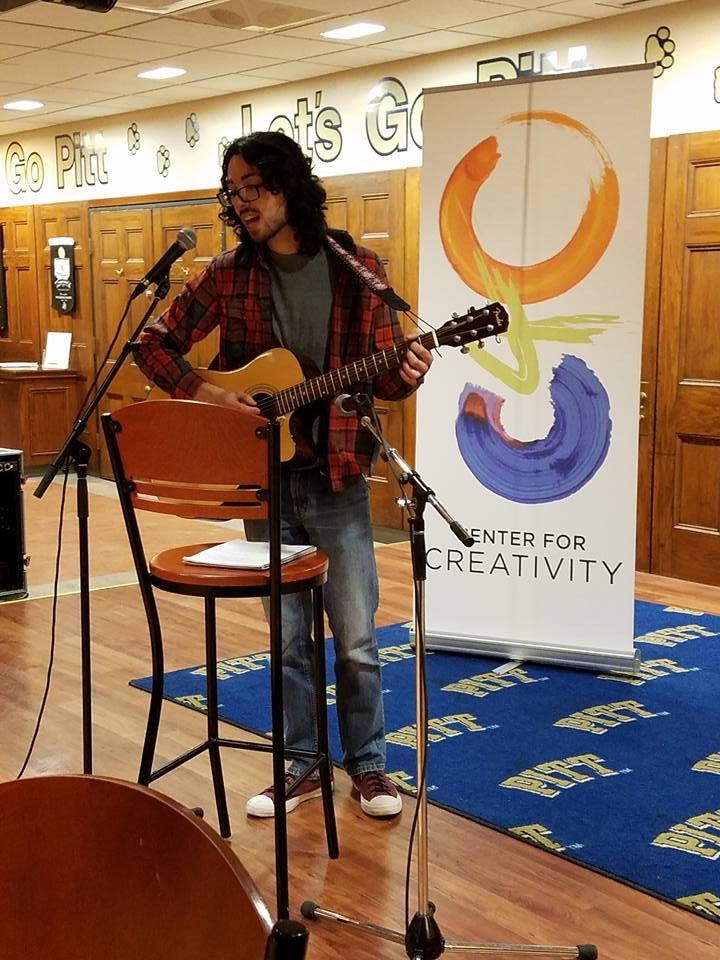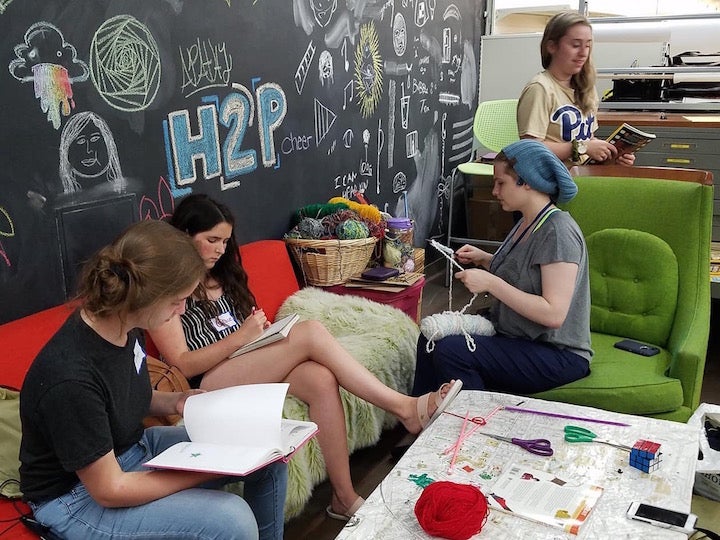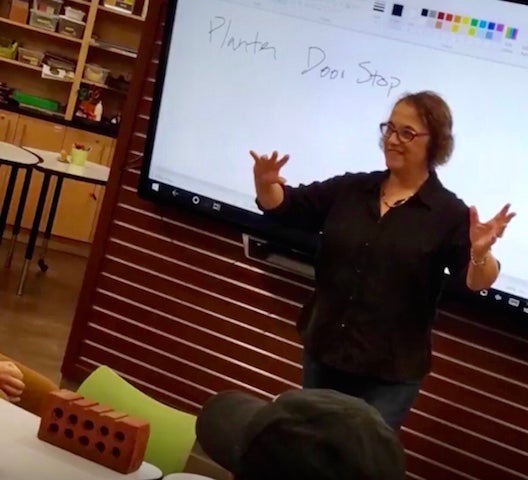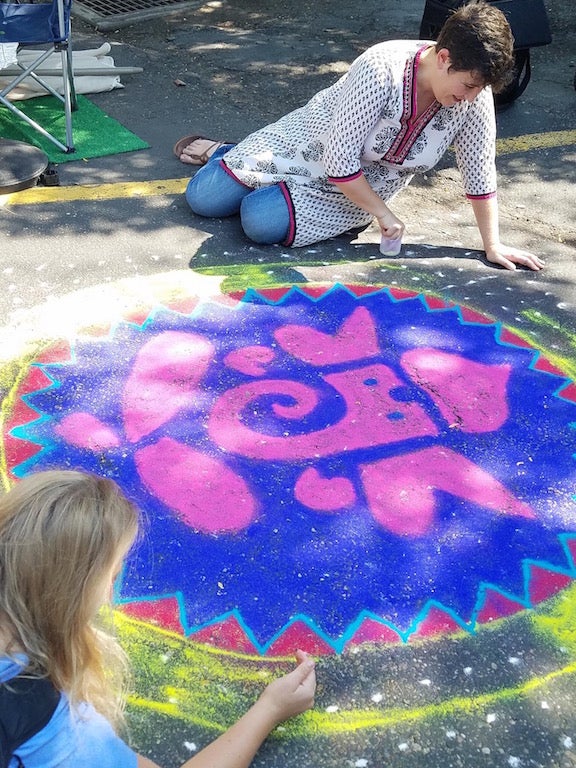A place for creators—not just “creatives”

C4C Open mic session in Nordy's Place/Photos courtesy the Center for Creativity
In the basement of the University Store on Fifth, occupying the space beneath the stairs and opposite the room filled with textbooks, is a lively, eclectic space that is home to the Center for Creativity. Often busy and pleasantly cluttered from frequent use, sometimes excitedly loud and other times peacefully quiet, this space is for every kind of creative expression: music, writing, drawing, knitting, painting, you name it.
With vibrant multicolored walls and a whiteboard on almost every surface, the C4C (the Center’s more casual abbreviation) is a lot like the no-holds-barred art studio I craved as a kid.
To be perfectly frank, I’m not sure I can even remember the time and place I first discovered the C4C during my time at Pitt. I do know that my first time actually creating in the space was with Pitt’s Office of Undergraduate Research, Scholarship, and Creativity. Visiting the C4C was, needless to say, a very fitting activity for the group. In fact, academic and social campus organizations often reserve the space, whether for a specific group activity or just to explore and de-stress.

Student find a relaxing place to make art at the C4C.
My first time in the C4C was the latter type of visit, during which I believe I made a bracelet, started knitting a scarf, and picked up a notebook of reflections of past C4C users who had filled up a page or two with what was on their mind. The C4C quickly became one of my favorite spots on campus, but one whose inner workings I knew very little about.
On any given day, the C4C might be bustling with activity, making it the perfect spot to jam out on the guitar; or softly murmuring with quiet whispers, the perfect place to pick up a good book. Faculty members, including English department instructors such as Hannah Eko and Zach Horton, bring classes there to discover new approaches to course questions and tasks. And, bonus: It’s one of the many places on campus that is free to students, faculty, and staff with a Pitt ID.
______________________________________________________________________________________
In preparation for this article, I sat down with C4C Workshop Manager Erik Schuckers and Director of Strategy and Partnership Kit Ayars to talk a little bit about the Center’s history and its role on campus.
The C4C’s first physical space downstairs from the University Store opened on campus in the spring of 2016, during the “Year of the Humanities at Pitt.” The brainchild of the Center’s director Jeanne Marie Laskas, a professor of, it was to be a space on campus for interdisciplinary interaction and collaboration. With energy and input from an initial steering committee, including English department Chair Don Bialostosky, Writing Program Associate Director Jeff Oaks, and staff member Nancy Kirkwood, C4C created a space where faculty, staff, and students of any discipline or level at the University could spend time creating together.

Persuasive Writing instructor Barbara Klein brainstorms with class at the C4C Workshop.
The C4C Workshop offers three types of organized events—workshops, sessions, and reserved events for individuals, campus organizations, and classes. Other spaces on campus also host special C4C events, such as open mic nights at Nordy’s Place in the William Pitt Union, where members of the Pitt community perform songs, poems, monologues, etc.
__________________________________________________________________
Another off-site event is the C4C’s annual PARK(ing) Day, when participating campus centers, departments, and student groups come together to beautify a campus parking space. Participants turn their spots into mini parks, performance spaces, or anything they want, transforming the concrete jungle into a creative space and engaging in what the C4C calls “tactical urbanism."

PARK(ing) Day brings campus parking spots to life.
The C4C partners with other University departments in offering some of its programs. For instance, the C4C Workshop partners with the University Counseling Center to encourage participants to create while exploring a mental health topic, such as how to express difficult emotions or cope with stress.
When talking about the origin of the C4C as a collaborative space, Ayars likened it to the idea of a coffee shop. Unless we’re counting the crowded Starbucks on campus, there probably aren’t a lot of other places where a poet might run into an engineer—both in the process of creating. Although the C4C is relatively new, its concept speaks to a more interdisciplinary tradition of creative collaboration within the University space, one that I’d only ever experienced before at the University Writing Center where I worked as a peer tutor.
Ayars, Schuckers, and I discussed the self-important notion of being a “creative.” While some use the word as an exclusive label only to be ascribed to serious career artists (e.g., painters, musicians, writers, etc.), others use it as a non-participatory excuse, claiming, “Oh, I’m not creative.” This was something I came across frequently in the Writing Center as well. While most tutees were very open to collaboration on their work, some would resist criticism and others would reject ownership of their work entirely, announcing at the beginning of the session that they were not a “writer”—as if there were only one definition of the word.
Schuckers also expressed his discomfort with the noun “creative.” He felt that the word is limiting, separating one population from another, when, really, everyone has the ability to create.
“Creativity is a process, and it is for everybody,” said Schuckers. “Creativity is making things. It doesn’t have to be an oil painting—it can be a doodle on the table.”
Ayars went on to talk a little bit more about what I’ve been calling in my head “casual creativity”—this idea that not every creative act we do has to result in a Picasso painting or the great American novel. Perhaps small acts of manageable creativity, like picking up a book that was not assigned in class for the first time in four years or simply writing a line of prose on one of the C4C’s many whiteboards, can unleash a spark of inspiration.

Jam sessions in the C4C.
As for the future, the C4C will have a second location in the newly renovated Hillman Library by the year 2020. Focused on text and context, this C4C "spoke" will include a Vandercook letterpress (I’m probably going to have to take a trip back to Pitt to check out what I’m missing!). Otherwise, they will just keep doing what they do best by creating a space where people feel comfortable, even encouraged, to enjoy the process of creativity—whatever that may look like for them.
In short: Creativity is about the process, not the product. Something that, as a recent graduate, I know is much more easily said than understood—and is much easier to remind myself in retrospect than it was during my four years as an undergrad. But I think it is a good and necessary reminder for every college student to take a second to slow down and savor the process. Creativity looks different for everyone, whether it’s on the job every day or for only a few free minutes each night. Regardless, where would the creative process be without the peer support and collaboration?
—Grace Cooper
Grace Cooper graduated in the spring of 2018 with degrees in English Writing and Psychology, as well as a certificate in Public and Professional Writing.
